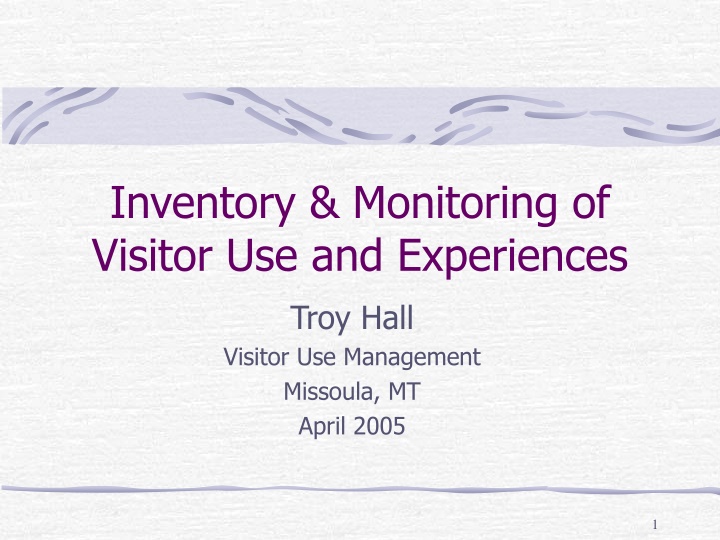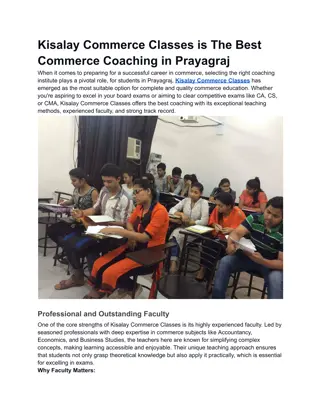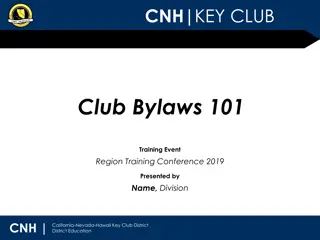Establishing a Commerce Club for Student Development
A Commerce club serves as a platform for students to engage in various activities, develop leadership skills, explore different occupations, and enhance their learning experience outside the classroom. Organizing meetings, tours, exhibitions, and other events under the supervision of teachers can provide valuable opportunities for students to grow and excel. The qualities of a teacher in charge play a crucial role in the success of such clubs, as they guide, support, and inspire students to make the most of their club involvement.
Download Presentation

Please find below an Image/Link to download the presentation.
The content on the website is provided AS IS for your information and personal use only. It may not be sold, licensed, or shared on other websites without obtaining consent from the author.If you encounter any issues during the download, it is possible that the publisher has removed the file from their server.
You are allowed to download the files provided on this website for personal or commercial use, subject to the condition that they are used lawfully. All files are the property of their respective owners.
The content on the website is provided AS IS for your information and personal use only. It may not be sold, licensed, or shared on other websites without obtaining consent from the author.
E N D
Presentation Transcript
Inventory & Monitoring of Visitor Use and Experiences Troy Hall Visitor Use Management Missoula, MT April 2005 1
What is inventory? What is monitoring? Why do we do them? 2
Social Impacts Conflict Crowding Solitude Experience Quality 3
How do you decide if you are providing high quality experiences? 4
Wilderness Experience: Solitude or a primitive and unconfined type of recreation 5
What conditions do you monitor? What conditions could you monitor to tell you about status and trends? 6
Do we monitor an indicator or the experience itself? 7
RMNP Backcountry/Wilderness Plan Visitors should have the opportunity for a variety of personal outdoor experiences, ranging from solitary to social The visitor experience should relate intimately to the splendor of the wilderness resource of RMNP Solitude and challenge are specifically emphasized; freedom discussed a little 8
White River NF Plan PRIMITIVE Moderate to high occasions of solitude while traveling and camping outside the trail corridors Moderate-to-high level of risk and challenge No more than 12 parties encountered per day on trail 80% of the time No more than 6 campsites in sight/sound 80% of the days PRISTINE Opportunities for solitude and self- reliance are excellent No more than two other parties encountered during cross-country travel per day on 80% of the days during each use season No other party within sight or sound of campsites should be encountered on 80% of the days in the summer and fall 9
White River NF Plan SEMI-PRIMITIVE Encounters with other users may be frequent low-to-moderate opportunities for solitude No more than 20 other parties encountered on trail 80% of the time No standard for camps in sight/sound 10
Mt. Hood Forest Plan Social Standards Encounters with other groups shall be limited to no more than ten groups per day in semi-primitive areas, and no more than six groups per day in primitive areas, during 80 percent of the primary recreational use season. 11
Selecting indicators what to monitor Not all indicators are equally useful Valid (significant), Relevant Measurable/Reliable Responsive 12
Selecting social indicators 3 main choices: 1. Document use trends 2. Observe visitors 3. Talk to visitors 13
1. Documentation of Use Levels Often done for overnight, but not day may require compliance checking Info can be quite valuable Can be costly John Muir/Ansel Adams and Dinkey Lakes FEIS 14
1. Documentation of Use Levels Many handbooks and examples are available Pros and cons of use measurement systems 15
2. Observing Visitors Documentation of encounters Other observations? 16
Monitoring Encounters - Considerations Source of data? Sampling Timing Duration Locations Training/standardization Definitions Additional data Concurrent data on use levels 19
Monitoring Encounters Using the Data Organization by location Standardizing time frame Analysis by day of week 20
Shenandoah Ranger Data on Encounters Cedar Run Jones Run Upper Hazel 80 70 60 Number/8 Hours 50 40 30 20 10 0 Weekend Groups Weekend People Weekday Groups Weekday People 21
Shenandoah Ranger Data on Encounters Cedar Run Jones Run Upper Hazel 80 70 60 Number/8 Hours 50 40 30 20 10 0 Weekend Groups Weekend People Weekday Groups Weekday People 22
Shenandoah Ranger Data on Encounters Cedar Run Jones Run Upper Hazel 80 70 60 Number/8 Hours 50 40 30 20 10 0 Weekend Groups Weekend People Weekday Groups Weekday People 23
Shenandoah Ranger Data on Encounters Cedar Run Jones Run Upper Hazel Mt. 100 90 80 70 60 Percent 50 40 30 20 10 0 % Time > Std Weekday % Time > Std Weekend 24
Encounter Rates, Mt. Hood Weekends Weekdays Percent of Time >10 Encounters 100 90 80 70 60 50 40 30 20 10 0 Ramona Falls Burnt Lake Timberline Elk Cloud Cap Top Spur Meadow 25
3. Talk to Visitors Less common as a form of monitoring Often used to help in setting standards 26
Shenandoah- Visitor Responses Encounters Per 8 Hours Cedar Run 27.5 Jones Run 9.2 Upper Hazel 28.6 27
Shenandoah- Visitor Responses Encounters Per 8 Hours % Felt Solitude % Time In Solitude Cedar Run 27.5 87 84.5 Jones Run 9.2 100 90.4 Upper Hazel 28.6 100 93.4 28
Talking to Visitors - Issues Obtaining visitor input OMB clearance What conditions to ask about How to ask specific questions Which people to survey Identifying proper indicators For many visitors, there s a weak correlation between encounters and solitude How to use the data 29
Coping with lack of resources Volunteers? Staggered observations? Internships? 30
Update: Wilderness Monitoring Committee Statutory qualities Natural Untrammeled Undeveloped Outstanding opportunities 31
Conclusions Understand why you are monitoring and how you will use the data before you start Consider the spatial and temporal scope of needed data How important is the issue? How accurate do you need to be? How much information do you need before you act? 32























